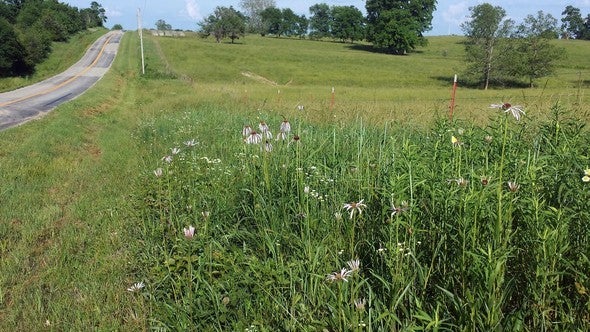
Xplor reconnects kids to nature and helps them find adventure in their own backyard. Free to residents of Missouri.


































Stay in Touch with MDC news, newsletters, events, and manage your subscription

Xplor reconnects kids to nature and helps them find adventure in their own backyard. Free to residents of Missouri.

A monthly publication about conservation in Missouri. Started in 1938, the printed magazine is free to residents of Missouri.




Kansas City, Mo. – Rare remnants of Missouri’s once-vast native grasslands still have viable roots and seeds in the soil of pastures, field corners, and hillsides. Some grasses and wildflowers linger unseen but are present among scattered trees in a never-plowed pasture. Missouri Department of Conservation’s (MDC) experts have shown that wise management gives prairie wildflowers and grasses renewed vitality for scenery, wildlife and farm profits.
“Remnants provide a refuge for grassland species of insects, wildlife, and plants,” said Stasia Whitaker, MDC wildlife management biologist. “They help preserve native plant genetic diversity. Depending on size, they’re not too hard to manage. A lot of people hay their remnants, to keep the hay and to reduce woody vegetation.”
The native grasses and wildflowers of Missouri’s once vast prairies, savannas, and woodlands served people and wildlife before pioneer settlement in the 1800s. Deer, elk, bison, and turkeys roamed the grasslands. The plants filtered rainwater running into prairie streams. Rich soils produced by prairie ecosystems furnished the basis for agriculture. Today, less than one percent of the state’s unplowed prairie remains.
However, pockets of unplowed grassland remain on many farms and acreages. Perhaps they were in a place difficult to grow and harvest field crops, or they were acres that farmers always used as grazing pasture or hay meadows. No matter how small or large, remnants have value. Colorful blooms in summer and rusty red autumn grasses are scenic and benefit pollinator insects and wildlife.
Native grassland remnants can also be a useful grazing patch for cattle during drought or in normal times. Warm season prairie grasses provide nutritional forage in mid- and late-summer months when nonnative cool season grasses are slowed or dormant. Many pastures or woodlands now dominated by nonnative plants may never have been plowed and can be restored to native grassland.
“Even the forbs (wildflowers) that grow in a native grassland can provide medicinal value to cattle and wildlife,” Whitaker said. “They are high in nutrients at a critical time when everything else is dry.”
Making remnants more natural and vibrant makes them more scenic and useful for wildlife and livestock. Grassland birds such as bobwhite quail nest and raise young in remnants.
“It’s impressive how many deer we have on our native grasslands,” Whitaker said.
Tips for prairie remnant management:
“Given the rarity of prairie plants, and the insects they benefit, remnants are valuable,” said Max Alleger, MDC regional administrator. “Probably, they offer some of the only overhead cover for wildlife in many upland areas.”
For more information on managing prairie remnants, visit https://short.mdc.mo.gov/ZHb.